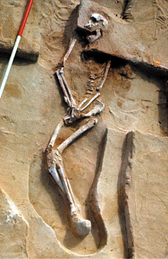Lake Mungo remains facts for kids
Quick facts for kids Lake Mungo |
|
|---|---|
| Location | |
| Region | Mungo National Park, New South Wales |
The Lake Mungo remains are very old human fossils found in Australia. They include Mungo Lady (also known as LM1), Lake Mungo 2 (LM2), and Mungo Man (LM3). These important discoveries were made near Lake Mungo in New South Wales. This area is part of the Willandra Lakes Region, which is a special World Heritage Site. Scientists have found parts of over forty human skeletons in this area. The Lake Mungo remains are the most important ones. They teach us a lot about the first people who lived in Australia.
Contents
Mungo Lady (LM1)
Mungo Lady (also called LM1) is the fossilised, or very old, remains of a young woman. Her body was cremated, meaning it was burned. She was found in 1969 by James Bowler.
Scientists used a method called Radiocarbon dating to find out how old she was. They found that LM1 is between 19,030 and 24,700 years old. Another test on Charcoal found near her burial showed it was about 26,250 years old. Studies of her bones suggest her body was burned, then broken, then burned again, before being buried.
Later research in 2003 used a different method called Optical dating. This suggested that both Mungo Lady and Mungo Man were buried around 40,000 years ago. This makes Mungo Lady the earliest known example of human cremation in the world. It shows that ancient indigenous Australians had complex burial rituals a very long time ago.
In 1992, Mungo Lady's bones were returned to the traditional owners of the land. These are the Paakantyi, the Mathi Mathi, and the Ngiyampaa people. Mungo Lady is now kept safely at the Mungo National Park visitor centre.
Mungo Man (LM3)
Mungo Man (also called LM3) was found by James Bowler in 1974. He was discovered when shifting sand dunes uncovered his remains. His burial site is about 500 metres east of where Mungo Lady was found.
Mungo Man's body was covered with red ochre. This is the oldest known example of such a detailed and artistic burial practice. Like Mungo Lady's cremation, this shows that ancient cultural traditions have existed in Australia for much longer than people first thought.
What Mungo Man Looked Like
Mungo Man was a slender person. This is different from the build of many modern indigenous Australians. His skeleton was not well preserved. Many parts of his skull were missing, and most of his limb bones were damaged.
Usually, scientists tell if a skeleton is male or female by looking at the skull and pelvis bones. But these bones were too damaged or missing for Mungo Man. So, scientists looked at other features. Most studies agree that Mungo Man was likely a male.
Mungo Man was buried lying on his back. His hands were joined together over his groin. Some of his bones show signs of osteoarthritis, which is a joint condition. His teeth were also very worn. This suggests that Mungo Man was quite old when he died, probably around 50 years old. New studies estimate his height to be about 196 centimetres (6 feet 5 inches). This is unusually tall for an Aboriginal person.
How Old is Mungo Man?
The first estimate of Mungo Man's age was made in 1976. Scientists from the Australian National University (ANU) thought he was between 28,000 and 32,000 years old. They estimated this by comparing his burial site to Mungo Lady's.
In 1987, a test called electron spin resonance on his bones suggested he was about 31,000 years old. In 1999, another test on quartz from his burial site showed he was older than 24,600 years and younger than 43,300 years.
Later in 1999, some research suggested Mungo Man was much older, around 62,000 years old. This estimate used different dating methods. However, this age was very controversial, and some of the methods were questioned.
In 2003, many Australian groups agreed that Mungo Man is about 40,000 years old. A team led by James Bowler did more tests. These tests suggested Mungo Man is not older than 50,000 years. This age of 40,000 years is now the most widely accepted age for Mungo Man. This makes him the oldest human fossil found in Australia. The 2003 study also found that Mungo Lady and Mungo Man are similar in age. It also showed that humans were present at Lake Mungo as early as 46,000 to 50,000 years ago.
Other Discoveries
In 1998, the remains of a child were found. Scientists believe this child lived around the same time as Mungo Man and Mungo Lady. In 2005, erosion uncovered another adult skeleton. Sadly, this skeleton was destroyed by wind and rain about a year later because it was not protected.
How Australia Was Settled
The main idea about how humans spread around the world is called the Out of Africa hypothesis. This idea says that humans first developed in Africa. From there, they spread to other parts of the world.
The discoveries at Lake Mungo are very important for understanding Australia's history. They show that people arrived in Australia much earlier than previously thought. The unique burial practices of Mungo Lady and Mungo Man also tell us about the complex cultures of these early Australians.
Images for kids
See also
 In Spanish: Restos del lago Mungo para niños
In Spanish: Restos del lago Mungo para niños





